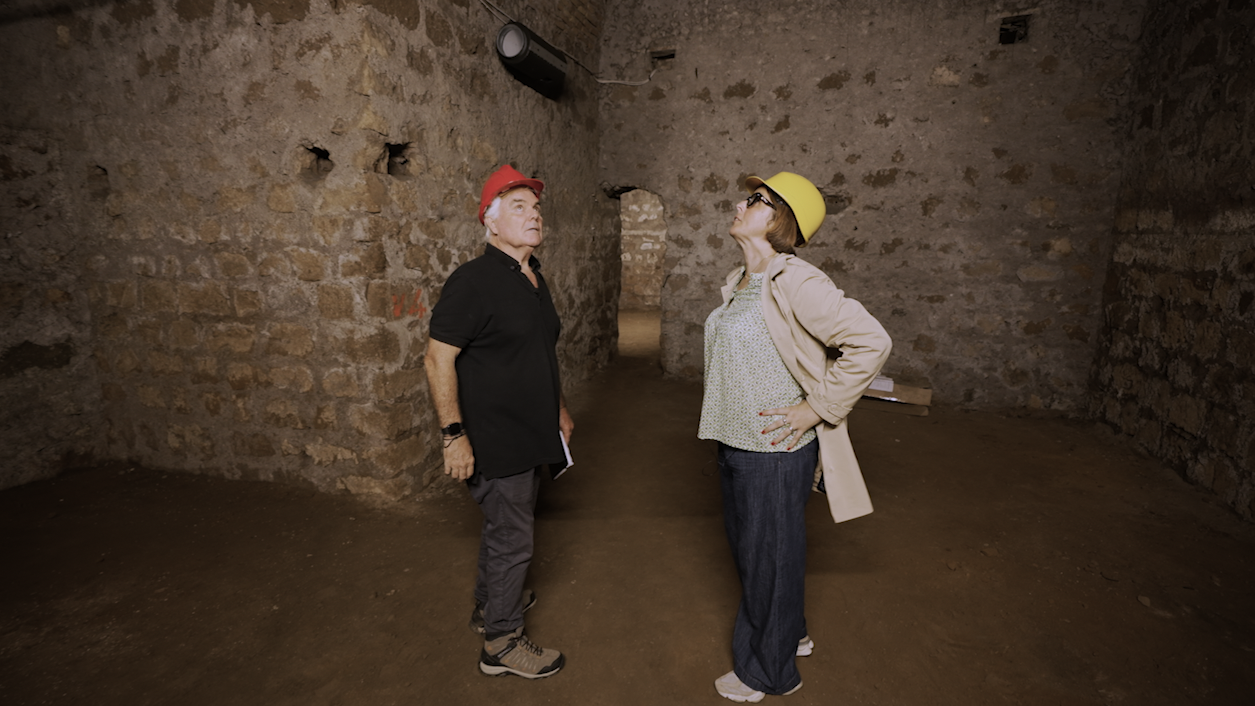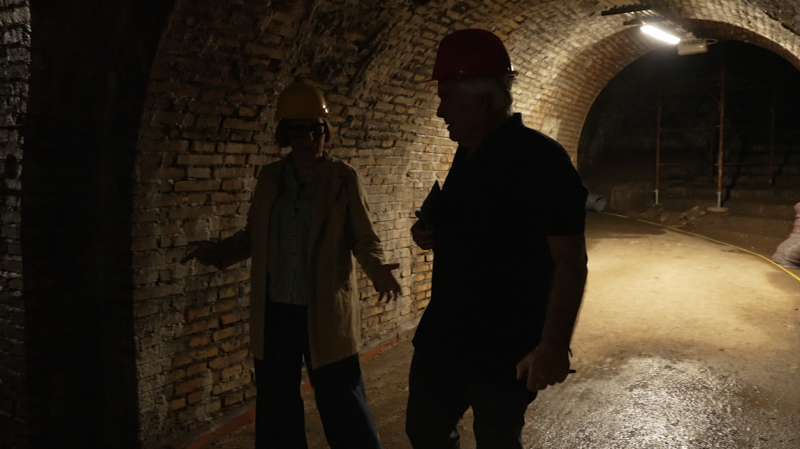Rome
—
There’s a reason archaeologist Ersilia D’Ambrosio can scarcely contain her excitement as she leads the way through dimly lit passageways deep below the Capitoline Hill that was once at the heart of ancient Rome: In a city where almost every historic treasure has been laid bare, this vast subterranean labyrinth is an undiscovered world.
“No one has seen these caves and tunnels for more than a century,” D’Ambrosio tells CNN, plunging further into the gloom. These chambers, which cover around 42,000 square feet, or 3,900 square meters — roughly three-quarters the area of an American football field — lie in an area beneath the Ancient Roman Forum and the 2,000-year-old Marcello Theater. At its deepest point, one of the caves extends about 985 feet below the surface.
Known as the Grottino del Campidoglio, or Capitoline Grotto, these tunnels have been part of the fabric of Rome even since before the days of Julius Caesar, despite being forgotten in recent generations. Comprehensively developed in the Middle Ages, they were in continuous use until the 1920s, at various times housing entire communities, shops, taverns, restaurants and, in World War II, people sheltering from falling Allied bombs.
Above ground, on the steamy morning in July when CNN was granted exclusive access to the cavern network, tourists sweated in temperatures of 95 degrees Fahrenheit (35 Celsius) as they explored the Capitoline Square, designed by Michelangelo in the 16th century, and the Capitoline Museums complex. Seventy-five feet below, in the grotto, it’s decidedly cooler at around 55F, with the damp air causing condensation to glitter on some of the tunnel surfaces.
Some of the passages are neatly constructed and lined with bricks, a sign of their development and use in the 19th century. Others are more roughly hewn from tuff, a soft volcanic rock from which the famous Seven Hills of Rome are formed. Walking through the tunnels is a trip back in time, with Rome’s complex layers of history laid bare.
Today, nearly a century after they were mostly sealed off under orders from Italy’s fascist dictator Benito Mussolini, the tunnels have been strung with illuminations, while scaffolding and other construction paraphernalia point to the fact that they are no longer abandoned. In fact, work is now underway to prepare the network for visitors. In late 2026 or early 2027, the tunnels will open as one of Rome’s newest historical tourist attractions.
For now, even for the experts working to get them ready, entering the Grottino del Campidoglio is still a journey of discovery. Despite much of the area, including the Imperial and Roman forums and the Colosseum nearby, undergoing extensive renovations in recent years, the tunnels have remained untouched.
D’Ambrosio says the grotto visitor experience is designed to combine archaeology and speleology, and will attract a different type of visitor from those who focus on the more well-known sites above ground. “This is an esoteric experience in many ways,” she adds. Although she’s built a long career on sites like these, D’Ambrosio manages the administration aspects of this particular project, but says her real love is getting her hands dirty.
There is still plenty for visitors to marvel at. Gazing up at a void reaching high above one block-lined tunnel, it’s possible to see the white marble foundation of the Temple of Jupiter, another Capitoline Hill treasure completed in the 6th century BCE.
The subterranean complex served many purposes over the centuries, first as stone quarries and later as water cisterns before eventually housing commercial structures and warehouses. In the 19th century, the caverns were once the economic epicenter of a working-class community that lived in modest public housing built along the flanks of the hill. German literary giant Johann Wolfgang von Goethe is said to have fallen in love with a woman who worked in one of the taverns, writing about the experience in his travelogue “Italian Journey.”
Little detail is known about exactly what each of the underground caverns held or when, but etchings by 18th-century Italian classical archaeologist and artist Giovanni Battista Piranesi show it as a lively part of the city center.
Mussolini tore down the housing and filled some of the tunnels with dirt to stabilize the hill above as part of his grand revitalization plan to modernize the Italian capital. During World War II, a small section was used as air raid shelters, complete with heavy fortified doors. Visible in the tunnels, as well as street numbers, are signs pointing to various “gabinetto” or bathrooms, likely used during the area’s phase as a sanctuary from falling bombs.

Hear from archeologist Ersilia d’Ambrosio about ancient tunnels beneath Rome

Work to open up this subterranean world to visitors is being completed in phases. Prior to clearing out the caves and tunnels, archaeologists used laser scanning to map the spaces and record marks left during previous excavation work. Photographic and video exhibitions of the work done will be part of a permanent display throughout the tunnel complex.
“The proposed interventions are aimed, on the one hand, at safeguarding the monument, through the restoration and safety of the structures, and, on the other, at enhancing its accessibility and usability, which is currently extremely limited,” according to the Insula architecture group, which is leading the project. “The Campidoglio Grottoes project envisions conservative restoration and enhancement of the underground passageways and cavities that wind through the hill, crossing it in various directions and on multiple levels.”
The work to make it safe for tourists also includes managing radon gas, which is naturally released from the volcanic rock that is being disturbed in the restoration process. Workers are constantly tested for levels of exposure, and the time they spend in the caves is limited. Specialized filters will be installed to scrub the air before the site opens to the public, says Antonio Collazzo, an archaeologist involved in the project. “This will be managed with a forced ventilation system.”
Once the $2.8-million undertaking is complete, there will be a museum space on an upper level, while entrance to the tunnels will be tightly controlled, with visitors led by guides to ensure their safety and the integrity of the delicate structure. Disabled access will also be added. There will be displays of ancient stone artifacts and a variety of pots and vases found buried in the dirt that were likely used by merchants for everything from olive oil to wine. Also visible will be metal rings attached to the walls, thought to have been used to tether animals brought down into the cave complex.
Artifacts and materials that were recovered during previous excavations of the area and stored in the Capitoline museum warehouses above have been brought down to the tunnels to be studied in their original context, D’Ambrosia says. “To an archaeologist everything is interesting,” she says. But only pieces likely to interest visitors are likely to remain in situ.

Even with all the current work going on, from above, there is little evidence on Capitoline Hill that there’s an extensive network of caves and tunnels below it. But Ambrosio is confident they will soon be a major attraction in a city with no shortage of them.
“The area has never before been opened to the public as it will be,” Ambrosio says. “It was utilized by the population, used as warehouses, shops, taverns, but never as a site to visit as it will be.”

